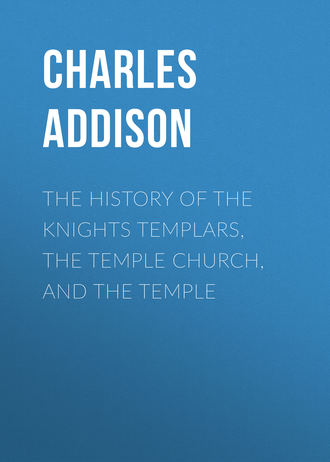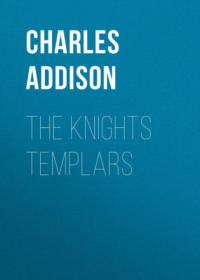 полная версия
полная версияThe History of the Knights Templars, the Temple Church, and the Temple
565
Prologue to the Canterbury Tales. The wages of the Manciples of the Temple, temp. Hen. VIII. were xxxvis. viiid. per annum. Bib. Cotton. Vitellius, c. 9. f. 320, a.
566
Annal. Olim-Sanctæ Mariæ Ebor.
567
Walsing. 4 Ric. 2. ad ann. 1381. Hist. p. 249, ed. 1603.
568
Rot. claus 5. E. 2. m. 19. Acta Rymeri, tom. iii. p. 292, 293, 294.
569
Unam robam per annum de secta liberorum servientium, et quinque solidos per annum, et deserviat quamdiu poterit loco liberi servientis in domo prædictâ. Ib. m. 2. Acta Rymeri, tom. iii. p. 331, 332.
570
Quolibet anno ad Natale Domini unum vetus indumentum de veteribus indumentis fratrum, et quolibet die 2 denarios pro victu garcionis sui, et 5 solidos per annum per stipendiis ejusdem garcionis, sed idem garcio deserviet in domo illâ. Ib.
571
Thomas of Wothrope, at the trial of the Templars in England, was unable to give an account of the reception of some brethren into the order, quia erat panetarius et vacabat circa suum officium. Concil. Mag. Brit., tom. ii. p. 355. Tunc panetarius mittat comiti duos panes atque vini sextarium… Ita appellabant officialem domesticum, qui mensæ panem, mappas et manutergia subministrabat. Ducange, Gloss. verb. panetarius.
572
Regula Templariorum, cap. lxvii. ante p. 25.
573
Concil. Mag. Brit., tom. ii. p. 371 to 373, ante, p. 235.
574
Dugd. Orig. Jurid., p. 212.
575
Nullus clericus nisi causidicus. Will. Malm., lib. iv. f. 69. Radulph de Diceto, apud Hist. Angl. Script. Antiq., lib. vii. col. 606, from whom it appears that the chief justitiary and justices itinerant were all priests.
576
Spelm. Concil., tom. ii. ad ann. 1217.
577
Innocentius, &c. … Præterea cum in Angliæ, Scotiæ, Walliæ regnis, causæ laicorum non imperatoriis legibus, sed laicorum consuetudinibus decidantur, fratrum nostrorum, et aliorum religiosorum consilio et rogatu, statuimus quod in prædictis regnis leges sæculares de cætero non legantur. Matt. Par., p. 883, ad ann. 1254, et in additamentis, p. 191.
578
Et quod ipsi quos ad hoc elegerint, curiam sequantur, et se de negotiis in eadem curia intromittant, et alii non. Et videtur regi et ejus concilio, quod septies vigenti sufficere poterint, &c. —Rolls of Parl. 20. E. 1. vol. i. p. 84, No. 22.
579
Dugd. Orig. Jurid., cap. xxxix. p. 102.
580
Ante, p. 118. Mace-bearers, bell-ringers, thief-takers, gaolers, bailiffs, public executioners, and all persons who performed a specific task for another, were called servientes, serjens, or serjeants. —Ducange Gloss.
581
Pasquier’s Researches, liv. viii. cap. 19.
582
Will. Tyr., lib. i. p. 50, lib. xii. p. 814.
583
Dugd. Hist. Warwickshire, p. 704.
584
Et tunc Magister Templi dedit sibi mantellum, et imposuit pileum capiti suo, et tunc fecit eum sedere ad terram, injungens sibi, &c. —Acta contra Templarios. Concil. Mag. Brit., tom. ii. p. 380. See also p. 335.
585
It has been supposed that the coif was first introduced by the clerical practitioners of the common law to hide the tonsure of those priests who practised in the Court of Common Pleas, notwithstanding the ecclesiastical prohibition. This was not the case. The early portraits of our judges exhibit them with a coif of very much larger dimensions than the coifs now worn by the serjeants-at-law, very much larger than would be necessary to hide the mere clerical tonsure. A covering for that purpose indeed would be absurd. The antient coifs of the serjeants-at-law were small linen or silk caps fitting close to the top of the head. This peculiar covering is worn universally in the East, where the people shave their heads and cut their hair close. It was imported into Europe by the Knights Templars, and became a distinguishing badge of their order. From the freres serjens of the Temple it passed to the freres serjens of the law.
586
Ex cod. MS. apud sub-thesaurarium Hosp. Medii Templi, f. 4. a. Dugd. Orig. Jurid. cap. 43, 46.
587
MS. in Bib. Int. Temp. No. 17. fo. 408.
588
Burton’s Leicestershire, p. 235.
589
After the courts of King’s Bench and Exchequer had by a fiction of law drawn to themselves a vast portion of the civil business originally transacted in the Common Pleas alone, the degree of serjeant-at-law, with its exclusive privilege of practising in the last-named court, was not sought after as before. The advocates or barristers of the King’s Bench and Exchequer were, consequently, at different times, commanded by writ to take upon them the degree of the coif, and transfer their practice to the Common Pleas.
590
Malcom. Lond. Rediviv., vol. ii. p. 282.
591
MS. Bib. Cotton. Vitellius, c. 9, fol. 320, a.
592
MS. Bib. Cotton, c. 9, fol. 320, a.
593
Hargrave, MS. No. 19, 81. f. 5. fol. 46.
594
MS. in Bib. In. Temp., No. 19, fol.
595
In. Temp. Ad. Parliament, ibm. XV. die Novembris Anno Philippi et Mariæ tertio et quarto, coram Johe Baker Milite, Nicho Hare Milite, Thoma Whyte Milite, et al. MS. Bib. In. Tem. Div. 9, shelf 5, vol. xvii. fol. 393.
596
Ex registr. In. Temp., f. 112, 119, b. Med. Temp., f. 24, a. Dugd., Orig. Jurid., p. 310, 311.
597
Ante, p. 180.
598
Dugd. Orig. Jurid. p. 316. Herbert Antiq., p. 223 to 272.
599
Leigh’s Armorie, fol. 119. ed. 1576.
600
Naunton’s Fragmenta Regalia, p. 248.
601
Chalmer’s Dict. Biograph., vol. xvii. p. 227.
602
Dugd. Orig. Jurid., p. 150. Ex registro Hosp. In. Temp. f. 123.
603
Whitelock’s Memorials, p. 18-22. Ed. 1732.
604
Dugd. Orig. p. 157. Biog. Brit. vol. xiv. p. 305.
605
Dugd. Orig. p. 158.
606
Harleian MS., No. 830.
607
MS. Bib. Cotton. Vitellius, c. 9. fol. 320 a.
608
See the examination of Brother Radulph de Barton, priest of the order of the Temple, and custos of the Temple Church, before the papal inquisitors at London. —Concil. Mag. Brit., tom. ii. p. 335, 337, ante, p. 221, 222.
609
Peck, Desiderata Curiosa, lib. xiii. p. 504, 505. Ed. 1779.


